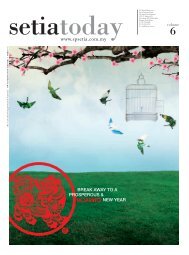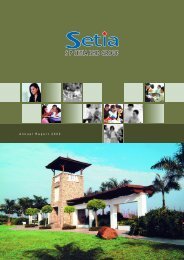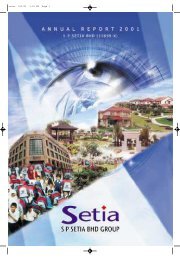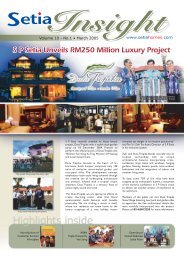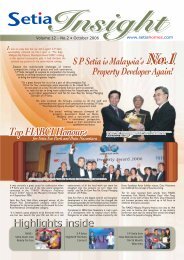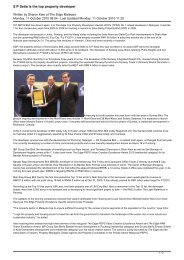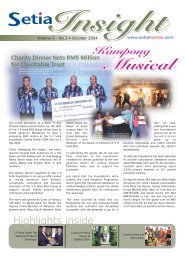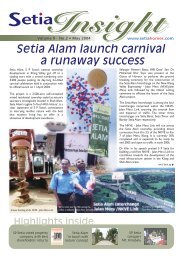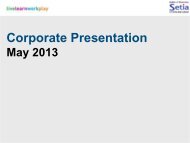Change - S P Setia Berhad
Change - S P Setia Berhad
Change - S P Setia Berhad
Create successful ePaper yourself
Turn your PDF publications into a flip-book with our unique Google optimized e-Paper software.
93<br />
S P <strong>Setia</strong> <strong>Berhad</strong> Group<br />
NOTES TO THE FINANCIAL STATEMENTS<br />
FOR THE YEAR ENDED 31 OCTOBER 2008<br />
1. SIGNIFICANT ACCOUNTING POLICIES (cont’d)<br />
(v)<br />
Impairment of assets (cont’d)<br />
(i)<br />
Goodwill (cont’d)<br />
An impairment loss is recognised in the income statement when the carrying amount of the cash-generating unit,<br />
including the goodwill, exceeds the recoverable amount of the cash-generating unit. Recoverable amount of the cashgenerating<br />
unit is the higher of the cash-generating unit’s fair value less cost to sell and its value in use.<br />
The total impairment loss is allocated first to reduce the carrying amount of goodwill allocated to the cash-generating<br />
unit and then to the other assets of the cash-generating unit proportionately on the basis of the carrying amount of<br />
each asset in the cash-generating unit.<br />
Impairment loss recognised on goodwill is not reversed in the event of an increase in recoverable amount in subsequent<br />
periods.<br />
(ii)<br />
Property, plant and equipment, investment properties, land held for property development, investment in subsidiary<br />
companies, associated companies and jointly controlled entities<br />
Property, plant and equipment, investment properties, land held for property development, investment in subsidiary<br />
companies, associated companies and jointly controlled entities are assessed at each balance sheet date to determine<br />
whether there is any indication of impairment.<br />
If such an indication exists, the asset’s recoverable amount is estimated. The recoverable amount is the higher of<br />
an asset’s fair value less cost to sell and its value in use. Value in use is the present value of the future cash flows<br />
expected to be derived from the asset. Recoverable amounts are estimated for individual assets or, if it is not possible,<br />
for the cash-generating unit to which the asset belongs.<br />
An impairment loss is recognised whenever the carrying amount of an asset or a cash-generating unit exceeds its<br />
recoverable amount. Impairment losses are charged to the income statement.<br />
Any reversal of an impairment loss as a result of a subsequent increase in recoverable amount should not exceed the<br />
carrying amount that would have been determined (net of amortisation or depreciation, if applicable) had no impairment<br />
loss been previously recognised for the asset.<br />
(w)<br />
Employee benefits<br />
(i)<br />
Short-term employee benefits<br />
Wages, salaries, paid annual leave, paid sick leave, bonuses and non-monetary benefits are recognised as an expense<br />
in the period in which the associated services are rendered by employees other than those that are attributable to<br />
property development activities or construction contract in which case such expenses are recognised in the property<br />
development costs or contract costs.<br />
(ii)<br />
Post-employment benefits<br />
The Company and its Malaysian subsidiary companies pay monthly contributions to the Employees Provident Fund<br />
(“EPF”) which is a defined contribution plan.<br />
The legal or constructive obligation of the Company and its Malaysian subsidiary companies is limited to the amount<br />
that they agree to contribute to the EPF. The contributions to the EPF are charged to the income statement in the<br />
period to which they relate.





